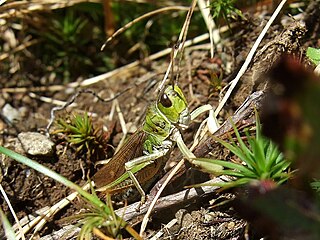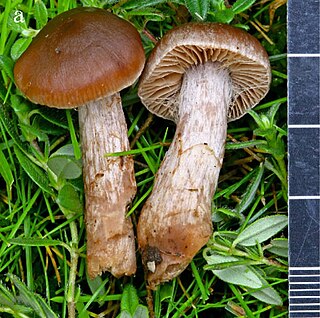
Characidae, the characids or characins is a family of freshwater subtropical and tropical fish, belonging to the order Characiformes. The name "characins" is the historical one, but scientists today tend to prefer "characids" to reflect their status as a by and large monophyletic group at family rank. To arrive there, this family has undergone much systematic and taxonomic change. Among those fishes that remain in the Characidae for the time being are the tetras, comprising the very similar genera Hemigrammus and Hyphessobrycon, as well as a few related forms such as the cave and neon tetras. Fish of this family are important as food and also include popular aquarium fish species.

The marionberry is a cultivar of blackberry released in 1956 by the USDA Agricultural Research Service breeding program in cooperation with Oregon State University. It is named after Marion County, Oregon where the berry was bred and tested extensively in the mid-20th century.

The steppe mammoth is an extinct species of mammoth that ranged over most of northern Eurasia during the Early and Middle Pleistocene, approximately 1.8 million-200,000 years ago. It evolved in East Asia during the Early Pleistocene, around 1.8 million years ago, before migrating into North America around 1.5 million years ago, and into Europe during the Early/Middle Pleistocene transition, around 1 to 0.7 million years ago. It was the ancestor of the woolly mammoth and Columbian mammoth of the later Pleistocene. Populations of steppe mammoth may have persisted in northern China and Mongolia as late as 33,000 years ago.

Lucien Quélet was a French naturalist and mycologist. Quélet discovered several species of fungi and was the founder of the Société mycologique de France, a society devoted to mycological studies.

Rubus armeniacus, the Himalayan blackberry or Armenian blackberry, is a species of Rubus in the blackberry group Rubus subgenus Rubus series Discolores Focke. It is native to Armenia and Northern Iran, and widely naturalised elsewhere. Both its scientific name and origin have been the subject of much confusion, with much of the literature referring to it as either Rubus procerus or Rubus discolor, and often mistakenly citing its origin as western European. Flora of North America, published in 2014, considers the taxonomy unsettled, and tentatively uses the older name Rubus bifrons.

The Armenian bumblebee is a species of bumblebee found in Greece, Austria, the Czech Republic, Russia, and the Near East.

Sidalcea stipularis is a rare species of flowering plant in the mallow family, known by the common name Scadden Flat checkerbloom.
Amblyseius armeniacus is a species of mite in the family Phytoseiidae.

Xerocomellus is a genus of fungi in the family Boletaceae. The genus, as it was described in 2008, contained 12 species. However X. rubellus and X. engelii were transferred to the new genus Hortiboletus and X. armeniacus was transferred to the new genus Rheubarbariboletus in 2015. Molecular analysis supports the distinction of Xerocomellus species from Boletus and Xerocomus, within which these species were formerly contained. Xerocomellus in fact is only distantly related to Xerocomus and is most closely related to Tylopilus, Boletus sensu stricto, Porphyrellus, Strobilomyces, and Xanthoconium.

Rheubarbariboletus armeniacus is a small mushroom in the family Boletaceae native to Europe. It was formerly placed in the genera Boletus, Xerocomus, and Xerocomellus. It acquired its current name when it was transferred to genus Rheubarbariboletus in 2015.
Glyptothorax armeniacus, the Armenian mountain catfish, is a species of catfish that was first described by Berg, 1918. Glyptothorax armeniacus is a species in genus Glyptothorax, family Sisoridae and order Siluriformes. No subspecies are listed in Catalogue of Life. It is endemic to southern and eastern Turkey.

Mount Ara is a polygenetic stratovolcanic cone in Armenia's Kotayk Province. The town of Zoravan and a nearby church, Gharghavank, are located along the mountain's lower slopes. The town of Yeghvard is below the mountain.

Rubus bifrons, the European blackberry or Himalayan blackberry, is a European species of flowering plant in the rose family. It is widespread across much of Europe and naturalized in scattered parts of North America. It is sometimes considered to include the species R. armeniacus.
Streptomyces armeniacus is a bacterium species from the genus Streptomyces which has isolated from soil. Streptomyces armeniacus produces streptopyrrole.

Gomphocerus is a genus of grasshoppers in the tribe Gomphocerini. Species can be found in Europe and Asia, with one species in South America.

Gnorimus is genus of beetles belonging to the family Scarabaeidae, subfamily Cetoniinae.

Cortinarius ainsworthii is a species of webcap. It is known from central and Northern Europe, where it grows in a variety of habitats. The species was first described in 2020, and was named in honour of the mycologist A. Martyn Ainsworth. Along with five other British webcaps, C. ainsworthii was selected by Kew Gardens as a highlight of taxa described by the organisation's staff and affiliates in 2020.

Streptopyrrole is an antibiotic with the molecular formula C14H12ClNO4 which is produced by the bacterium Streptomyces armeniacus














